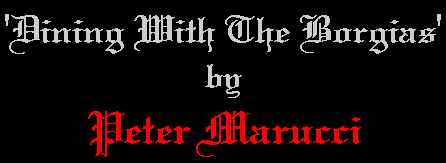
Lecture14 Marruci.

| Effect:
"The Borgias - the very name of this 15th century Italian family
still causes shivers up the spine. Lucrezia Borgia, and her brother
Cesare, were notorious for their involvements in court intrigues and
assassinations."
"A favorite 'weapon'
of Lucrezia was reputed to be poison and a dinner invitation to the
Borgias was almost like sealing your doom. The magus lays out six cards, face down. "Here are six cards; you (to the spectator) are being offered one of them. If you are lucky, you will survive and drink what is on the other side with no ill effects. If you are not, well, the usual Borgia fate awaits. Please tap the back of any one of the six cards (Spectator does so). You may stay with that one, or change your mind (When the spectator has decided on a card, slide it out from the rest, still face down). "You could have selected any of these other five cards but fate, destiny, kismet - call it what you will - led you to that card." The magus picks up the five unselected cards, showing them to be all the same; the chosen card is different. NOTE:
There are two possible endings for the trick: The five cards show a
skull and crossbones, all signifying poison, while the spectator's card
is a wine goblet (not
poisoned); or, the
five cards are all goblets while the spectator's card is the skull and
crossbones (poison). The three pictures in each set should be exactly the same. Lay the cards out in a row, face down, with three goblets on one side (say, the left) and three skulls on the other (say, the right). When the spectator picks a card, slide it out of the row and pick up the other five, starting with the set of three, face down, and then the two remaining cards, also face down, on top of the three. Turn the packet face up,
in a Biddle grip, in the right hand. Show the first card (say it's a
skull). Move the right hand to the left, drawing off the top, face-up
card with the left thumb and let it fall to the left palm. Repeat with
the next card, which will be a match. The spectator now turns
over her card and it is a different card (in
this example, the
goblet). Finish by
complimenting her on escaping the fate of so many who dine with the
Borgias. If the chosen card is a skull, show the other five as goblets,
and commiserate with the spectator for having fallen victim to the fate
of those who dine with the Borgias. You can fill in more details on the Borgias if you wish but remember you are supposed to be entertaining the audience, not lecturing to them; so keep it relatively short. My original version of this effect, based on Aladdin and his lamp (but also referring to the Prince and Frog, and another version referring to Dracula), appeared in my column in the Linking Ring in September of 1993 but I enjoyed performing them long before this. Hope you enjoy performing this further version. Peter Marucci. |
| All the material in this lecture is copyrighted with all rights reserved to Peter Marucci, 2002. |